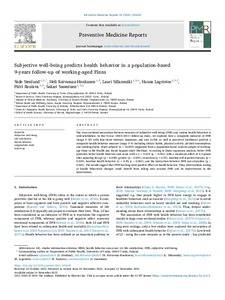| dc.contributor.author | Lagström Hanna | |
| dc.contributor.author | Suominen Sakari | |
| dc.contributor.author | Stenlund Säde | |
| dc.contributor.author | Rautava Päivi | |
| dc.contributor.author | Sillanmäki Lauri | |
| dc.contributor.author | Koivumaa-Honkanen Heli | |
| dc.date.accessioned | 2022-10-28T14:41:05Z | |
| dc.date.available | 2022-10-28T14:41:05Z | |
| dc.identifier.uri | https://www.utupub.fi/handle/10024/172759 | |
| dc.description.abstract | <p>The cross-sectional association between measures of subjective well-being (SWB) and various health behaviors is well-established. In this 9-year (2003–2012) follow-up study, we explored how a composite indicator of SWB (range 4–20) with four items (interest, happiness, and ease in life, as well as perceived loneliness) predicts a composite health behavior measure (range 0–4) including dietary habits, physical activity, alcohol consumption, and smoking status. Study subjects (n = 10,855) originated from a population-based random sample of working-age Finns in the Health and Social Support study (HeSSup). According to linear regression analysis, better SWB predicted better health behavior sum score with a β = 0.019 (p < 0.001) with a maximum effect of 0.3 points after adjusting for age (p = 0.038), gender (p < 0.001), education (p = 0.55), baseline self-reported diseases (p = 0.020), baseline health behavior (β = 0.49, p < 0.001), and the interaction between SWB and education (p < 0.001). The results suggest that SWB has long-term positive effect on health behavior. Thus, interventions aiming at health behavioral changes could benefit from taking into account SWB and its improvement in the intervention.<br></p> | |
| dc.language.iso | en | |
| dc.publisher | Elsevier Inc. | |
| dc.title | Subjective well-being predicts health behavior in a population-based 9-years follow-up of working-aged Finns | |
| dc.identifier.url | https://www.sciencedirect.com/science/article/pii/S2211335521003260?via%3Dihub | |
| dc.identifier.urn | URN:NBN:fi-fe2021120859716 | |
| dc.relation.volume | 24 | |
| dc.contributor.organization | fi=kansanterveystiede|en=Public Health| | |
| dc.contributor.organization | fi=väestötutkimuskeskus|en=Centre for Population Health Research (POP Centre)| | |
| dc.contributor.organization | fi=tyks, vsshp|en=tyks, vsshp| | |
| dc.contributor.organization-code | 2607008 | |
| dc.contributor.organization-code | 2607307 | |
| dc.converis.publication-id | 67960472 | |
| dc.converis.url | https://research.utu.fi/converis/portal/Publication/67960472 | |
| dc.identifier.eissn | 2211-3355 | |
| dc.identifier.jour-issn | 2211-3355 | |
| dc.okm.affiliatedauthor | Rautava, Päivi | |
| dc.okm.affiliatedauthor | Lagström, Hanna | |
| dc.okm.affiliatedauthor | Suominen, Sakari | |
| dc.okm.affiliatedauthor | Sillanmäki, Lauri | |
| dc.okm.affiliatedauthor | Dataimport, tyks, vsshp | |
| dc.okm.affiliatedauthor | Stenlund, Säde | |
| dc.okm.discipline | 3142 Public health care science, environmental and occupational health | en_GB |
| dc.okm.discipline | 3142 Kansanterveystiede, ympäristö ja työterveys | fi_FI |
| dc.okm.internationalcopublication | international co-publication | |
| dc.okm.internationality | International publication | |
| dc.okm.type | Journal article | |
| dc.publisher.country | United States | en_GB |
| dc.publisher.country | Yhdysvallat (USA) | fi_FI |
| dc.publisher.country-code | US | |
| dc.relation.articlenumber | 101635 | |
| dc.relation.doi | 10.1016/j.pmedr.2021.101635 | |
| dc.relation.ispartofjournal | Preventive Medicine Reports | |
| dc.year.issued | 2021 | |
